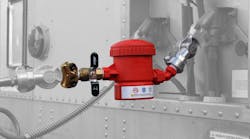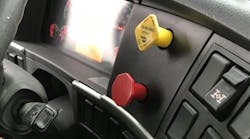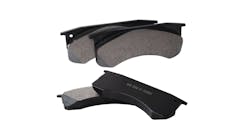Trailer brakes are one of the most neglected service areas of combination tractor-trailers for fleets.
One reason for this is that fleet drivers “drop and hook” trailers. In other words, they are usually picking up a different trailer every trip, so they never know its history. The previous driver may not have been as diligent about daily air tank draining and left moisture in the trailer’s brake lines.
Managing moisture
When I cover the air brake unit of my diesel technician training course, we walk out to the parking lot and check truck air tanks. The students are amazed at the water in both the primary and secondary tanks. Over my years of doing this survey, virtually every parked truck drained some amount of water.
This accumulated moisture finds its way into the trailer brake system and can cause various issues, especially during winter months in cold weather regions across the U.S. Ice crystals in a trailer’s airlines can lock up brakes, creating a cold morning annoyance, and in some cases, a dangerous on-the-road jackknife.
Moisture can be a bigger issue if the trailer has a disabled anti-lock braking system (ABS). For example, the fuse may be removed to keep the amber ABS alert light from illuminating. When the ABS light is disabled, that means these trailers now function like they have standard brakes, but still have ABS valves. If there’s moisture in the lines, those ABS valves can trap moisture, freeze up, and cause brakes to not operate properly.
As stability control systems become standard on all new trucks, managing moisture in trailer brake lines becomes more important. If stability control is working properly, jackknives are reduced by 66 percent and rollovers are reduced by 68 percent, according to braking and safety system supplier Bendix. But stability control requires that the trailer’s ABS be operational, which U.S. DOT inspections have shown is often not the case.
Variables with system freezing
Some believe moisture is not an issue because modern trucks have air dryers. Let’s look at this from a technical perspective for a minute. Coming out of the compressor, the air is extremely hot. The air has to be cooled down before it goes through the dryer. There’s a long line with a heat dissipater that the air travels through to bring the temperature down to below 212 degrees F before it hits the dryer.
Next, the cooled air moves to the dryer, which will get out most, but not all, of the moisture. Even if the dryer air gets down to 180 degrees F, once the truck is parked the airline will drop to the ambient temperature. So, if it’s 40 degrees F outside, there will be moisture accumulation simply because it’s below the dew point. Is it possible to ever get the air completely dry? Never.
Now there is moisture in the system. Here's what can cause parts of the system to freeze: While on the road, the driver applies and releases the brakes, which causes an increase or decrease in pressure. When the pressure drops, any moisture in the system condenses. Remember, the higher the pressure, the higher the boiling point of water. So, when the brakes are released, the pressure quickly decreases from 125 psi toward zero, creating moisture droplets that can find their way into the valves. The colder the weather, the faster these droplets can freeze. This usually happens when the vehicle is parked but it can occur when driving down the road as well.
Valves can freeze while opened or closed. If the outlet valve freezes while open, a driver cannot apply the trailer brakes. If the outlet valve freezes while closed, the driver can’t release the brakes. Because there are several valves, any combination of events can occur.
How to handle frozen brake lines
It is important that fleets have a policy and training in place to teach drivers how to properly manage frozen trailer brakes. There are a few ways drivers can choose to deal with frozen brake lines in the field, including:
Torch it
Many veteran drivers have crawled under a trailer with a torch and hammer to free up frozen brakes. They heat up the values to try to melt the ice crystals, being careful not to melt any hoses or ABS circuits. Then, with a hammer, they tap the slack adjusters on the air chambers of each wheel and the brake shoes to see if the brake has released. This method can obviously lead to damaged components.
Pull it
Often a driver will try to use brute force to drag a frozen trailer hoping to jar loose ice crystals. This will only work if the brake lining is frozen to the drum, but the driver has no way to tell whether it’s the lines or the drums that are frozen. This method can cause costly expenses such as damaged components and flat spots on the trailer tires.
Call it
If these methods don’t work, or the driver can’t crawl under the trailer, it means a costly service call. No one wants to waste time, delay a shipment, or pay for a service call.
Pour it
Another solution is using antifreeze or an air brake deicer. Chemicals in the deicer melt the ice crystals in the airline without requiring heat or an open flame.
Pouring deicer directly into the brake line is hard to do and it’s difficult to tell if enough has been added to be effective. Some brake system manufacturers discourage using certain deicers or antifreeze solutions for fear that they could remove some of the internal lubrication from the seals, so be sure to use a solution approved for the vehicle’s brake system.
As a preventive measure, a tool like Milton Industries’ Brake Releaser can make it easier to add an effective amount of deicing fluid to the lines. To use, the driver detaches the gladhands and attaches the Brake Releaser tool on the emergency brake line, pours in 6 oz to 8 oz of deicer, and presses the red emergency brake button in the cab. It is important to remove the Brake Releaser tool when this process is completed, and to not drive with it attached while the vehicle is in operation. Milton Industries says the entire process should take about five minutes.
None of these methods are perfect; there are pros and cons to each method above. But winter weather and road conditions are also far from perfect. If the alternative is jackknifing or sitting by the side of the road of a Wyoming mountain pass for eight hours waiting for service, one of these methods may be the lesser of two evils.
Frozen trailer brakes are annoying. But more than that, how drivers deal with the problem can mean costly repairs, delivery delays, and safety issues. Providing drivers the training and tools they need to manage frozen brakes quickly and safely can make all the difference.
Bill Peek is a heavy duty truck curriculum developer and instructor. With a training career spanning more than 25 years, Peek has taught in 47 U.S. states and three Canadian provinces. Peek created the Modern Diesel Diagnostics course, including the unit on air brake systems with fellow trainer Doc Nall. Peek is president of MPC Publishing, a print, video, and digital training provider. Previously, he was Director of Product Development at specialty tool manufacturer OTC. Peek can be reached by phone at (219) 252-3148 or email at [email protected].







